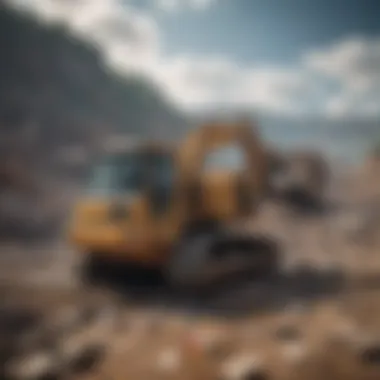Unveiling the Ecological Impact of Construction Waste Dumps on the Environment


Overview of the Topic
Construction trash dumps pose a significant threat to the environment, causing detrimental effects and necessitating sustainable waste management practices. The irresponsible disposal of construction waste has far-reaching consequences on ecosystems and communities, underlining the urgency for environmentally conscious solutions. Understanding the impact of these trash dumps is crucial in advocating for effective measures to minimize ecological damage.
Current Status and Challenges
At present, construction trash dumps continue to proliferate, exacerbating environmental degradation. The sheer volume of waste generated from construction activities poses a serious challenge, overwhelming existing waste management systems. Improper disposal methods lead to soil, water, and air pollution, further intensifying the plight of already vulnerable ecosystems. Managing construction waste effectively remains a daunting task, with inadequate regulations and enforcement adding to the complexity of this environmental issue.
Sustainable Solutions
Addressing the challenges posed by construction trash dumps requires a multidimensional approach towards sustainable waste management. Implementing recycling programs, promoting reuse of materials, and adopting innovative technologies for waste treatment are pivotal in mitigating environmental harm. Successful case studies showcasing the benefits of recycling construction materials and reducing waste generation offer tangible solutions to combat the escalating problem of construction trash dumps. Embracing sustainable practices not only minimizes environmental impact but also contributes to the conservation of natural resources for future generations.
Impact and Importance
The impact of construction trash dumps extends beyond immediate environmental harm, affecting ecosystems, human health, and the well-being of future generations. Soil contamination from hazardous construction waste can have lasting consequences on agricultural productivity and water quality. Additionally, the emission of greenhouse gases through improper waste disposal contributes to climate change, further perpetuating environmental degradation. Recognizing the importance of conservation efforts and sustainable resource management is paramount in safeguarding the planet for present and future inhabitants, necessitating a paradigm shift towards responsible waste practices.
Introduction
In this comprehensive exploration of the impact of construction trash dumps on the environment, we delve deep into the intricate web of consequences stemming from unsustainable waste management practices. The significance of this topic lies in its ripple effect on soil health, water purity, and air quality, ultimately affecting both human health and ecological balance. By unraveling the complexities of construction trash dumps, we can glean valuable insights into mitigating their detrimental effects and steering towards more sustainable solutions.
Understanding Construction Trash Dumps
Definition of Construction Trash Dumps
The term 'construction trash dumps' denotes designated sites where waste generated from construction activities is deposited. These dumps serve as collection points for various materials, including concrete debris, wood scraps, and hazardous substances like asbestos. The distinctive feature of construction trash dumps is their function as repositories for the byproducts of building processes. While facilitating waste containment, they also pose challenges in terms of managing potentially harmful elements efficiently.
Types of Waste Found in Construction Trash Dumps
Construction trash dumps harbor a diverse array of waste materials, ranging from non-biodegradable plastics to toxic chemicals used in construction. This variety poses unique challenges in terms of segregation and disposal methods. The assortment of waste found in these dumps spans from bulky items like metal beams to particulate matter like paint chips. Understanding the composition of waste in construction dumps is crucial for devising effective waste management strategies tailored to the specific needs of each material type.
Significance of the Issue
Environmental Impact of Construction Trash Dumps
The environmental ramifications of construction trash dumps reverberate across landscapes, seeping into the soil and polluting water bodies. The pervasive nature of this impact underscores the urgency of addressing waste disposal practices in the construction industry. Mitigating the environmental fallout requires a multi-faceted approach that considers the interconnectedness of ecosystems and the delicate balance of natural resources.


Challenges Posed by Improper Waste Disposal
Improper waste disposal in construction trash dumps poses a myriad of challenges, from leachate contamination to greenhouse gas emissions from decomposing organic matter. Addressing these challenges necessitates stringent regulations and robust enforcement mechanisms to curb irresponsible waste disposal practices. The repercussions of neglecting proper waste management protocols can have far-reaching consequences on public health and environmental integrity.
Purpose of the Article
Raising Awareness about the Consequences of Construction Trash Dumps
A key objective of this article is to shed light on the far-reaching consequences of overlooking responsible waste disposal in construction activities. By raising awareness about the ecological footprint of construction trash dumps, we aim to instigate collective action towards more sustainable waste management practices. Empowering stakeholders with knowledge about the repercussions of their actions is a vital step towards fostering environmental stewardship and resource conservation.
Advocating for Sustainable Waste Management Practices
Advocacy for sustainable waste management practices forms the backbone of this article's mission. By promoting the adoption of eco-friendly strategies for waste disposal and recycling in the construction sector, we advocate for a paradigm shift towards circular economy principles. Embracing sustainability not only safeguards the environment but also nurtures a culture of responsible resource utilization and stewardship for future generations.
The Environmental Toll
Construction trash dumps have a profound impact on the environment, posing a significant risk to various ecosystems. The accumulation of construction waste not only degrades the soil quality but also leads to water pollution and air quality degradation. Understanding the environmental toll of these trash dumps is crucial for implementing effective mitigation strategies. By addressing soil contamination, water pollution, and air quality degradation, we can work towards a more sustainable future.
Soil Contamination
Effects of Construction Waste on Soil Quality
Construction waste can have detrimental effects on soil quality by introducing harmful substances and altering natural soil composition. The improper disposal of construction materials like concrete, metals, and chemicals can contaminate the soil, impacting its fertility and biodiversity. This contamination can disrupt plant growth, harm beneficial microorganisms, and leach toxins into the ground. Addressing the effects of construction waste on soil quality is essential to preserve ecosystem health and prevent long-term damage.
Risk of Soil Pollution from Hazardous Materials
Construction trash dumps often contain hazardous materials that pose a serious risk of soil pollution. Substances like lead, asbestos, and solvents can seep into the soil, contaminating it and endangering both human health and the environment. The risk of soil pollution from these materials highlights the importance of proper waste management practices and the need for stricter regulations to prevent soil degradation.
Water Pollution
Impact of Leachate from Trash Dumps on Water Sources
Leachate from construction trash dumps can contaminate water sources, presenting a significant threat to aquatic ecosystems and human populations. As rainwater percolates through the waste, it picks up pollutants and toxins, carrying them into rivers, lakes, and groundwater reserves. This contaminated water not only affects aquatic life but also poses risks to public health. Understanding the impact of leachate on water sources is crucial for safeguarding water quality and ecosystem balance.
Contamination of Groundwater and Aquatic Ecosystems
The contamination of groundwater and aquatic ecosystems by construction waste poses grave consequences for biodiversity and ecosystem stability. Chemicals and pollutants leaching from trash dumps can disrupt the balance of aquatic habitats, leading to fish kills, algae blooms, and long-term water quality issues. Protecting groundwater and aquatic ecosystems from contamination is essential for preserving biodiversity and ensuring the sustainability of water resources.


Air Quality Degradation
Emissions of Harmful Gases from Decomposing Waste
Decomposing waste in construction trash dumps releases harmful gases into the atmosphere, contributing to air quality degradation and posing health risks to nearby communities. Methane, a potent greenhouse gas, is generated during the decomposition of organic matter in the waste, exacerbating climate change and respiratory problems. Addressing the emissions of harmful gases from decomposing waste is critical for mitigating air pollution and safeguarding public health.
Health Risks Associated with Poor Air Quality
Poor air quality resulting from construction trash dumps can have severe health implications for individuals living in proximity to these sites. Inhalation of airborne pollutants from decomposing waste can lead to respiratory issues, cardiovascular problems, and other adverse health effects. Understanding the health risks associated with poor air quality is essential for advocating for stricter environmental regulations and prioritizing public health in waste management practices.
Legal and Regulatory Framework
In delving into the impact of construction trash dumps on the environment, one paramount aspect that emerges is the Legal and Regulatory Framework. This facet plays a pivotal role in shaping the narrative around sustainable waste management practices, particularly in the construction sector. Through the lens of Legal and Regulatory Framework, the article aims to dissect the existing laws and guidelines governing the disposal of construction waste, shedding light on their effectiveness and areas that necessitate improvement.
Existing Regulations
Laws governing construction waste disposal
When dissecting the Laws governing construction waste disposal, a focal point in understanding the legal landscape, the emphasis rests on how these regulations shape waste management practices. Specifically, these laws detail the permissible methods of disposing of construction waste, aiming to curb ecological harm and promote responsible waste handling within the industry. The key characteristic of Laws governing construction waste disposal lies in their ability to establish a standard for waste management, fostering accountability among stakeholders. Their stringent guidelines serve as a safeguard against improper disposal, ensuring that construction activities align with environmental preservation efforts. However, despite their benefits in reinforcing eco-friendly practices, challenges such as compliance monitoring and enforcement gaps warrant attention to fortify their efficacy in tackling environmental issues.
Implementation challenges and loopholes
Turning to the aspect of Implementation challenges and loopholes, this section examines the real-world hurdles in translating regulatory mandates into on-the-ground actions. The crux of this discussion revolves around the practical barriers hindering seamless compliance with waste disposal regulations. Highlighting the complexity of the construction waste ecosystem, this subsection underscores the intricacies involved in adhering to legal norms amidst operational constraints. Despite the overarching advantages of regulatory frameworks, the presence of loopholes and implementation challenges poses persistent threats to effective waste management. Addressing these obstacles demands a multi-faceted approach encompassing enhanced monitoring mechanisms, stakeholder engagement, and streamlined enforcement practices to close the gaps and elevate compliance levels.
Policy Recommendations
Proposed measures to strengthen waste management policies
Within the realm of Policy Recommendations, the focus shifts towards identifying avenues to bolster waste management policies for construction activities. The spotlight is on innovative strategies aimed at enhancing the regulatory framework to better address environmental concerns. By proposing measures to strengthen waste management policies, the article advocates for proactive interventions that promote sustainable waste practices. These proposed solutions encompass a spectrum of initiatives ranging from promoting recycling initiatives to incentivizing eco-conscious behaviors among industry players. Their unique feature lies in their adaptability to dynamic environmental challenges, offering a responsive and forward-thinking approach to mitigating the impact of construction trash dumps on the ecosystem.
Enforcement strategies for ensuring compliance
Lastly, the discourse navigates towards Enforcement strategies for ensuring compliance, delineating the mechanisms through which regulatory mandates translate into tangible outcomes. This segment accentuates the significance of robust enforcement strategies in upholding the integrity of waste management regulations. By elucidating the key characteristic of Enforcement strategies for ensuring compliance as a vital link between policy formulation and on-ground implementation, the narrative underscores the indispensable role of enforcement mechanisms in fostering adherence to environmental standards. While these strategies exhibit a proactive stance in reinforcing regulatory compliance, their effectiveness hinges on addressing challenges such as resource constraints, legal ambiguities, and stakeholder cooperation, shaping a holistic approach towards sustainable waste management.
Technological Innovations
In the realm of sustainable waste management, technological innovations play a crucial role in mitigating the adverse effects of construction trash dumps on the environment. These advancements offer promising solutions to address the challenges posed by improper waste disposal, aiming towards a more sustainable future. By embracing technological innovations, the construction industry can significantly reduce its ecological footprint and contribute to a healthier planet.


Advanced Recycling Methods
Utilization of Recycled Materials in Construction
The strategic use of recycled materials in construction is a pivotal aspect of sustainable waste management practices. Through the utilization of recycled resources, construction activities can significantly decrease the demand for virgin materials, subsequently reducing energy consumption and minimizing environmental impact. This practice aligns with the overarching goal of this article, which is to promote eco-friendly solutions for waste management. The key characteristic of utilizing recycled materials lies in its ability to not only conserve natural resources but also in curbing the proliferation of construction waste in landfills. Despite its advantages, challenges such as variations in material quality and availability must be considered when implementing recycled materials in construction.
Innovative Recycling Technologies
Innovative recycling technologies showcase immense potential in revolutionizing how construction waste is managed. These cutting-edge approaches encompass advanced processes that enhance the recycling efficiency and expand the scope of recyclable materials. Addressing the pressing need for sustainable waste management, innovative recycling technologies are a popular choice for their efficiency and effectiveness in dealing with construction trash dumps. The unique feature of these technologies lies in their ability to process complex waste streams into valuable resources, thus promoting a circular economy. While their advantages are evident in waste reduction and resource conservation, factors like initial investment costs and technological complexities may pose limitations in implementing these innovative solutions.
Waste-to-Energy Solutions
Converting Waste into Usable Energy Sources
The concept of converting waste into usable energy sources presents a paradigm shift in addressing the environmental challenges associated with construction trash dumps. By harnessing energy from waste materials, this approach not only reduces the volume of waste requiring disposal but also generates a sustainable energy source. This innovative strategy aligns closely with the theme of this article by promoting effective waste management techniques. The key characteristic of converting waste into energy lies in its dual benefit of waste diversion and renewable energy production. The unique feature of this approach is its capacity to tackle the twin issues of waste management and energy generation simultaneously, offering a holistic solution to environmental sustainability.
Benefits and Limitations of Waste-to-Energy Systems
Evaluating the benefits and limitations of waste-to-energy systems is essential in understanding their impact on the environment and waste management practices. These systems provide a valuable opportunity to reduce greenhouse gas emissions, alleviate pressure on landfills, and foster renewable energy production. However, it is crucial to acknowledge the limitations related to technology maturity, emission control, and operational costs in implementing waste-to-energy solutions. Despite the advantages of energy generation and waste reduction, careful consideration of these systems' environmental implications and economic feasibility is imperative for their successful integration into sustainable waste management practices.
Community Engagement
Community engagement plays a pivotal role in addressing the environmental challenges posed by construction trash dumps. It involves actively involving local residents, organizations, and stakeholders in sustainable waste management practices and initiatives. By educating and empowering communities, it cultivates a sense of ownership and responsibility towards environmental conservation. Furthermore, community engagement fosters collaboration and collective action, essential for implementing impactful solutions to mitigate the detrimental effects of construction waste on the ecosystem.
Education and Awareness Programs
Promoting Waste Reduction Practices
Promoting waste reduction practices is a fundamental aspect of community engagement in tackling the issue of construction trash dumps. This initiative aims to minimize the generation of waste and encourage efficient resource utilization. The key characteristic of promoting waste reduction practices lies in its ability to instill behavioral changes among individuals and communities towards a more sustainable lifestyle. Through educational campaigns and outreach programs, promoting waste reduction practices emerges as a proactive and effective strategy for reducing environmental impact.
Educational Campaigns on Responsible Disposal
Educational campaigns on responsible disposal are crucial in raising awareness about the proper handling and disposal of construction waste. By disseminating information on waste segregation, recycling methods, and environmentally friendly practices, these campaigns influence public behavior towards responsible waste management. The unique feature of educational campaigns is their ability to target specific audiences, tailoring messages to address their needs and concerns effectively. While advantageous in promoting consciousness and responsible behavior, educational campaigns may face challenges in reaching diverse demographics and sustaining long-term engagement.
Local Initiatives
Community-Driven Cleanup Efforts
Community-driven cleanup efforts involve collaborative activities initiated by local residents to clean up littered areas and remove construction waste debris. These initiatives not only contribute to improving the aesthetics of the community but also have environmental benefits by preventing further pollution and habitat degradation. The key characteristic of community-driven cleanup efforts is the sense of community pride and environmental stewardship they foster. While popular for their immediate impact and community bonding, these efforts may encounter limitations in terms of scalability and long-term sustainability.
Collaborative Projects for Waste Management
Collaborative projects for waste management encompass joint efforts between local authorities, businesses, and community groups to implement sustainable waste management practices. By pooling resources and expertise, these projects aim to enhance waste collection, recycling, and disposal processes. The unique feature of collaborative projects lies in their holistic approach towards waste management, addressing the entire waste lifecycle from generation to disposal. While advantageous in promoting shared responsibility and resource optimization, collaborative projects may face challenges in terms of coordination, funding, and stakeholder alignment.



